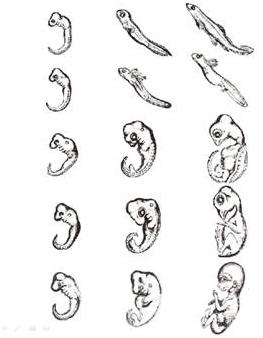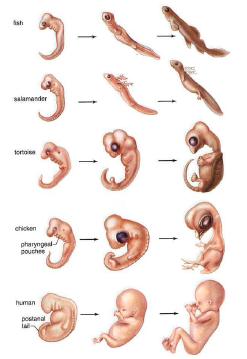 Education
Education
 Evolution
Evolution
Textbooks Cherry-Pick the Evidence for Evolution
| Series on Problems with Current Textbook Treatments of Evolution
• Full Report: “An Evaluation of 22 Recent Biology Textbooks And Their Use of Selected Icons of Evolution” |
In presenting their case for evolution, the textbooks reviewed in our 2011 textbook report, “An Evaluation of 22 Recent Biology Textbooks and Their Use of Selected Icons of Evolution,” repeatedly cherry-pick the data to support evolution. There are more examples of this than I could possibly ever hope to have time or space to discuss here on ENV. The report details many such examples, but this article will highlight just a few of the many distressing instances where textbooks overstate or misrepresent the evidence for evolution.
BSCS Biology: A Molecular Approach (Glencoe/McGraw Hill, 2006)
This “molecular”-focused textbook selectively presents data in favor of neo-Darwinian evolution. For example, it cites “non-functioning pseudogenes” as evidence of evolution (p. 531) and earned an F for the icon of junk DNA. It also fails to mention evidence of potential functions for pseudogenes or instances where functions for pseudogenes have been discovered.
Similarly, on page 227 it portrays the cytochrome-c phylogenetic tree and the anatomy-based tree and states, “These two methods generally agree.” (p. 530) However, it cherry-picks data from the cytochrome-c tree and fails to mention that the cytochrome-b tree exhibits significant differences from a standard phylogeny based upon the fossil record or comparative anatomy. As one article in Trends in Ecology and Evolution stated:
[T]he mitochondrial cytochrome b gene implied . . . an absurd phylogeny of mammals, regardless of the method of tree construction. Cats and whales fell within primates, grouping with simians (monkeys and apes) and strepsirhines (lemurs, bush-babies and lorises) to the exclusion of tarsiers. Cytochrome b is probably the most commonly sequenced gene in vertebrates, making this surprising result even more disconcerting.
The textbook also argues in a circle by portraying homology as evidence for common ancestry and vice versa. First, it states that “A homology is a characteristic that is similar among different organisms because they evolved from a common ancestor.” (p. 107) However, it then claims that homology is evidence for common ancestry, stating: “Homologies are characteristics that suggest common ancestry.” (p. 108) In this example of circular reasoning, no mention is made of genetic or developmental evidence that does not fit with evolutionary claims regarding homology.
Sylvia S. Mader, Jeffrey A. Isaacson, Kimberly G. Lyle-Ippolito, Andrew T. Storfer, Inquiry Into Life (13th ed., McGraw Hill, 2011)
This 2011 textbook dogmatically states that “The fossil record and biogeography, as well as studies of comparative anatomy and development, and biochemistry, all provide evidence for evolution” (p. 566) — ignoring much data that is contrary to these claims. Ironically, it then uses recolorized and slightly redrawn versions of Haeckel’s inaccurate drawings to provide inaccurate “evidence for evolution”:
| Haeckel’s Original Drawings | Mader (2011) |  |
 |
National Geographic, Alton Biggs, Lucy Daniel, Edward Ortleb, Peter Rillero, Dinah Zike, Life Science (McGraw Hill, Glencoe, 2005)
This textbook provides a good example of how the Miller-Urey experiment is often misrepresented. It contains a diagram explaining Miller-Urey with a caption claiming that “Stanley Miller and Harold Urey sent electric currents through a mixture of gases like those thought to be in Earth’s early atmosphere.” (p. 20) There is no qualification of this statement, and the reader is left with the impression that the experiment produced amino acids in earthlike conditions.
This textbook is aimed at a younger audience than many of the other textbooks evaluated here, but it too promotes faux-inquiry. After overstating the similarities among vertebrate embryos, it asserts: “Similarities in embryos of fish, chickens, and rabbits show evidence of evolution. Evaluate these embryos as evidence for evolution.” (p. 167) If the textbook tells students that the evidence supports evolution, what will their conclusion be when they “evaluate” the evidence? Another question instructs students to “Think Critically” and “Compare and contrast the five types of evidence that support the theory of evolution.” Students are supposed to “Think Critically” — but not about whether the evidence supports evolution. That is taken as a given.
Eric J. Simon, Jane B. Reece, Jean L. Dickey, Campbell Essential Biology (Benjamin Cummings, 4th ed., 2010)
This textbook has a typically dogmatic opening, stating that evolution is “the theme that unifies all of biology” (p. 3) and “the core theme of biology.” (p. 18) It soon thereafter states that Darwin’s conclusion is “inescapable”: “As evolutionary biologist Stephen Jay Gould put it, Darwin based his mechanism of natural selection on ‘two undeniable facts and an inescapable conclusion.'” (p. 11)
To bolster such assertions, this textbook claims that “selected DNA sequences of chimps and humans are better than a 98% match” (p. 251), ignoring evidence to the contrary that human and chimp DNA in fact exhibits larger differences, and that in any event this does not demonstrate common ancestry.
The textbook also dramatically overstates and misrepresents Craig Venter’s research, claiming that he “synthesized from scratch the entire genome of Mycoplasma genitalium.” (p. 293) Venter didn’t synthesize it from scratch: his team simply copied all the genetic code from a pre-existing bacterium. The textbook claims that this may “help answer fundamental questions about the origins of life in nature,” but ironically, Venter’s research shows that intelligence is needed to create life.
Peter H. Raven, George B. Johnson, Kenneth A. Mason, Jonathan B. Losos, and Susan R. Singer, Biology, (9th ed., McGraw Hill, 2011)
The textbook includes a single drawing of what it calls a “generalized embryo” (p.694), which the authors apparently mean to represent the embryos of all vertebrates. This is extremely misleading, perhaps even more so than Haeckel’s drawings, as it does not even hint that there are differences between the embryos of various chordates in their early stages.
This textbook also makes an outlandish and wholly speculative statement in favor of human evolution: “The difference of only two amino acids between humans and other primate FOXP2 appears to have made it possible for language to arise.” (p. 485) Could two amino acid changes have created language in humans? Apparently this textbook expects students to believe that it did.
Cecie Starr, Ralph Taggart, Christine Evers, Lisa Starr, Biology: The Unity and Diversity of Life (12th ed. 2009)
This textbook promotes myths about evolution such as the claim that humans “use our legs, but not our coccyx bones.” (p. 261) It also promotes materialist views of the origin of life as well as the fallacy that extraterrestrial life somehow necessarily would support an unguided chemical origin of life:
Suppose scientists do find evidence of past or present microbial life on another planet. Would it matter? Such a discovery would support the hypothesis that life can arise spontaneously as a consequence of chemical reactions. (p. 328)
In what initially appears to be a positive statement, the book contains a “Guide to Critical Thinking” which encourages students to ask questions like “Is there another way to interpret the evidence?” or “What other evidence would help me evaluate the alternatives?” (p. 11) Unfortunately, when it comes to Darwinian evolution, the textbook does not practice what it preaches, offers no alternatives and never discusses non-Darwinian ways to interpret the evidence.
There are numerous other examples where recently published biology textbooks overstate the evidence for evolution. For details, see our full report, “An Evaluation of 22 Recent Biology Textbooks And Their Use of Selected Icons of Evolution.”
